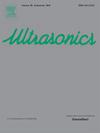Defect localization in heterogeneous plate structures using the geometric phase change – index of Lamb waves
IF 3.8
2区 物理与天体物理
Q1 ACOUSTICS
引用次数: 0
Abstract
Defect localization in homogeneous structures using ultrasonic waves is relatively easy to implement. However, locating defects in heterogeneous structures made of different materials can be challenging. This is because complicated reflections, refractions and scatterings occur when ultrasonic waves pass through the interfaces between two dissimilar materials of the heterogeneous structures. To address this issue, a localization methodology based on geometric phase change – index (GPC-I), derived from topological acoustic (TA) sensing, is proposed to adapt to the complicated scenarios when defects are present in heterogeneous plate structures. The GPC-I is adopted as the damage index (DI) to present the possibility of defects appearing on different acoustic sensing paths. A maximum peak value-dependent threshold in GPC-I plots (GPC-I vs. sensor sites) is defined to filter out unreliable sensing paths resulting from the heterogeneity. Different sensing modes (I and II) are combined to comprehensively provide a more reliable and accurate localization framework. Numerical modeling carried out by Abaqus/CAE software verifies the proposed GPC-I based localization technique. Comparison results among GPC-I and other two commonly used acoustic parameters—wave velocity differences (VD) and amplitude ratio (AR) (or wave attenuation) show that the GPC-I has superiority with higher sensitivity and stability for defect localization. This work can provide promising guidance for localizing defects in complex heterogeneous plate structures used in real-world engineering applications.
求助全文
约1分钟内获得全文
求助全文
来源期刊

Ultrasonics
医学-核医学
CiteScore
7.60
自引率
19.00%
发文量
186
审稿时长
3.9 months
期刊介绍:
Ultrasonics is the only internationally established journal which covers the entire field of ultrasound research and technology and all its many applications. Ultrasonics contains a variety of sections to keep readers fully informed and up-to-date on the whole spectrum of research and development throughout the world. Ultrasonics publishes papers of exceptional quality and of relevance to both academia and industry. Manuscripts in which ultrasonics is a central issue and not simply an incidental tool or minor issue, are welcomed.
As well as top quality original research papers and review articles by world renowned experts, Ultrasonics also regularly features short communications, a calendar of forthcoming events and special issues dedicated to topical subjects.
 求助内容:
求助内容: 应助结果提醒方式:
应助结果提醒方式:


